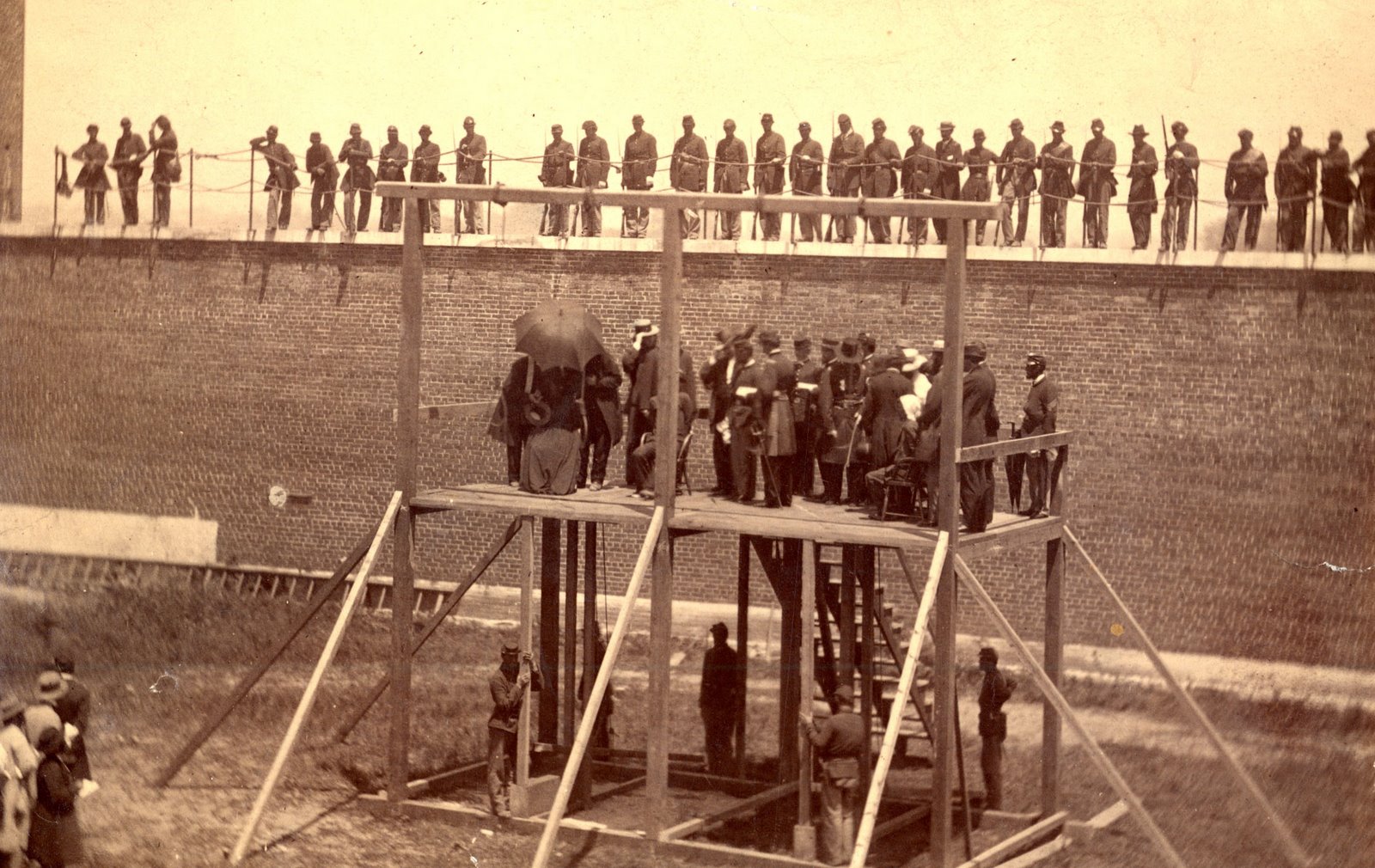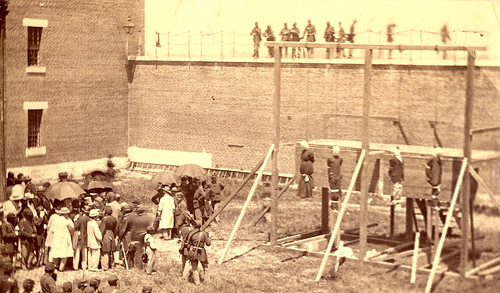Abraham Lincoln Documents and Ephemera
January 30, 2009
Description by Katie Hargrave, Archives and Special Collections assistant and graduate student in Cultural Production
 On April 15, 1865, newspapers were given the awful task of announcing the assassination of the 16th president of the United States: Abraham Lincoln. The night before went down in history with one gunshot. John Wilkes Booth, an actor and confederate, mortally shot President Lincoln at Ford's Theater in Washington, D.C., jumped from the balcony, and yelled, "sic semper tyrannis" ("thus always to tyrants") as he fled the scene. One must wonder, on this bicentennial of Lincoln's birth, at the final meaning of the words Booth uttered. Booth's intended meaning-that tyrants shall always perish at the hands of the righteous-is flipped on its head, as it is Booth who has been remembered as tyrant and not the much-beloved President Lincoln. However, at the time of Lincoln's death, Booth was not alone in his hatred of the president. The divisive nature of the Civil War and Lincoln's Emancipation Proclamation precipitated several earlier threats, and a band of conspirators acted with Booth on that fateful night.
On April 15, 1865, newspapers were given the awful task of announcing the assassination of the 16th president of the United States: Abraham Lincoln. The night before went down in history with one gunshot. John Wilkes Booth, an actor and confederate, mortally shot President Lincoln at Ford's Theater in Washington, D.C., jumped from the balcony, and yelled, "sic semper tyrannis" ("thus always to tyrants") as he fled the scene. One must wonder, on this bicentennial of Lincoln's birth, at the final meaning of the words Booth uttered. Booth's intended meaning-that tyrants shall always perish at the hands of the righteous-is flipped on its head, as it is Booth who has been remembered as tyrant and not the much-beloved President Lincoln. However, at the time of Lincoln's death, Booth was not alone in his hatred of the president. The divisive nature of the Civil War and Lincoln's Emancipation Proclamation precipitated several earlier threats, and a band of conspirators acted with Booth on that fateful night.
 Only a short three months later, on July 7, 1865, four of the conspirators, Mary Surratt, Lewis Payne, George Atzerodt and David Herod, who worked with Booth, were hanged in Washington D.C. at Ft. McNair. The public hanging was witnessed by thousands, including women and children. Photographs of the conspirators hanging, like these from Brandeis Special Collections, taken by Alexander Gardner, were reproduced in newspapers and as souvenirs. Surratt, the most remembered of the conspirators, was the first woman condemned to death by the federal government. According to the Washington Post, the spot where they were hanged is now a tennis court.[1]
Only a short three months later, on July 7, 1865, four of the conspirators, Mary Surratt, Lewis Payne, George Atzerodt and David Herod, who worked with Booth, were hanged in Washington D.C. at Ft. McNair. The public hanging was witnessed by thousands, including women and children. Photographs of the conspirators hanging, like these from Brandeis Special Collections, taken by Alexander Gardner, were reproduced in newspapers and as souvenirs. Surratt, the most remembered of the conspirators, was the first woman condemned to death by the federal government. According to the Washington Post, the spot where they were hanged is now a tennis court.[1]
 Though documents like the newspaper announcing Lincoln’s assassination and photographs of the conspirators hanging are now collectors’ items, more interesting perhaps are the contemporaneous memorabilia produced following his death. Lincoln’s visage has graced all types of goods, from the copper cent to bookends to postcards. The collection of Lincoln memorabilia at Brandeis includes many of these posthumously produced objects. We also hold some more unusual pieces, like a small sewing box “made of wood which grew near Alloway Kirk on the banks of the Doon,” referring to the River Doon at the town Alloway Kirk; a miniature book, Addresses of Abraham Lincoln, printed by Kingsport press in 1929, measuring 1.5 by 2 centimeters and containing four of Lincoln’s more famous speeches; a silhouette modeled on the Lincoln cent made entirely out of “worn out paper money destroyed at the U.S. Treasury”; and a carte-de-visite printed by Boston-based illustrator G.W. Tomlinson dating from 1865 and depicting George Washington crowning Lincoln with laurels. In addition to the types of objects showcased here, our holdings include letters written by Lincoln when he was living in Springfield, Illinois, as well as many printed photographs, lithographs and engravings of Lincoln, his generals and his family.
Though documents like the newspaper announcing Lincoln’s assassination and photographs of the conspirators hanging are now collectors’ items, more interesting perhaps are the contemporaneous memorabilia produced following his death. Lincoln’s visage has graced all types of goods, from the copper cent to bookends to postcards. The collection of Lincoln memorabilia at Brandeis includes many of these posthumously produced objects. We also hold some more unusual pieces, like a small sewing box “made of wood which grew near Alloway Kirk on the banks of the Doon,” referring to the River Doon at the town Alloway Kirk; a miniature book, Addresses of Abraham Lincoln, printed by Kingsport press in 1929, measuring 1.5 by 2 centimeters and containing four of Lincoln’s more famous speeches; a silhouette modeled on the Lincoln cent made entirely out of “worn out paper money destroyed at the U.S. Treasury”; and a carte-de-visite printed by Boston-based illustrator G.W. Tomlinson dating from 1865 and depicting George Washington crowning Lincoln with laurels. In addition to the types of objects showcased here, our holdings include letters written by Lincoln when he was living in Springfield, Illinois, as well as many printed photographs, lithographs and engravings of Lincoln, his generals and his family.
 As a part of the bicentennial celebration of Lincoln’s birth, the Robert D. Farber Archives and Special Collections department is lucky to be able to present not only this Special Collections Spotlight on our own Lincoln holdings but also a physical exhibit of Lincoln memorabilia collected by Brandeis alumnus Brian Caplan ’82, which opens on February 10 with a celebration in the Treasure Hall from 5-9 p.m. The exhibition will be on display in the Archives and Special Collections exhibit space through June of 2009.
As a part of the bicentennial celebration of Lincoln’s birth, the Robert D. Farber Archives and Special Collections department is lucky to be able to present not only this Special Collections Spotlight on our own Lincoln holdings but also a physical exhibit of Lincoln memorabilia collected by Brandeis alumnus Brian Caplan ’82, which opens on February 10 with a celebration in the Treasure Hall from 5-9 p.m. The exhibition will be on display in the Archives and Special Collections exhibit space through June of 2009.
Notes
January 30, 2009



